Detailed Report on Sensors: Functionality, Types, and Applications
VerifiedAdded on 2023/04/19
|7
|1890
|167
Report
AI Summary
This report provides an overview of sensors, defining them as devices that detect environmental changes and convert them into measurable signals. It discusses key sensor requirements like linearity, response time, and sensitivity, classifying sensors by stimuli such as optical, mechanical, and thermal. The report details the components of a sensor, including the sensor element, signal processing hardware, and connections, and explores specific types like proximity sensors, motion sensors, photoresistors, and resistive sensors. Practical applications, principles of transduction, and the significance of measurement systems are also examined. The report concludes by emphasizing the importance of sensors in various systems and their role in detecting and responding to physical stimuli, with references to relevant research and publications.
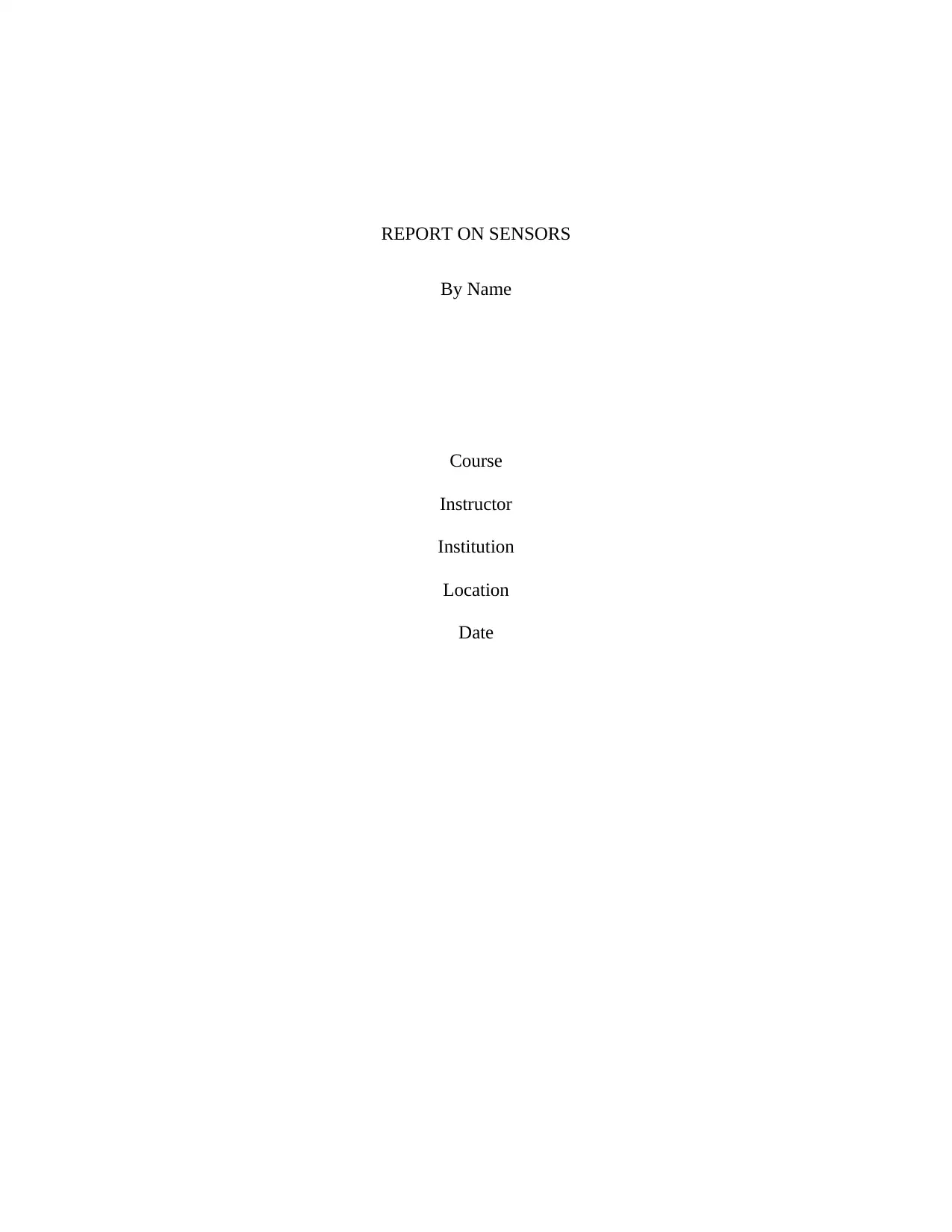
REPORT ON SENSORS
By Name
Course
Instructor
Institution
Location
Date
By Name
Course
Instructor
Institution
Location
Date
Paraphrase This Document
Need a fresh take? Get an instant paraphrase of this document with our AI Paraphraser
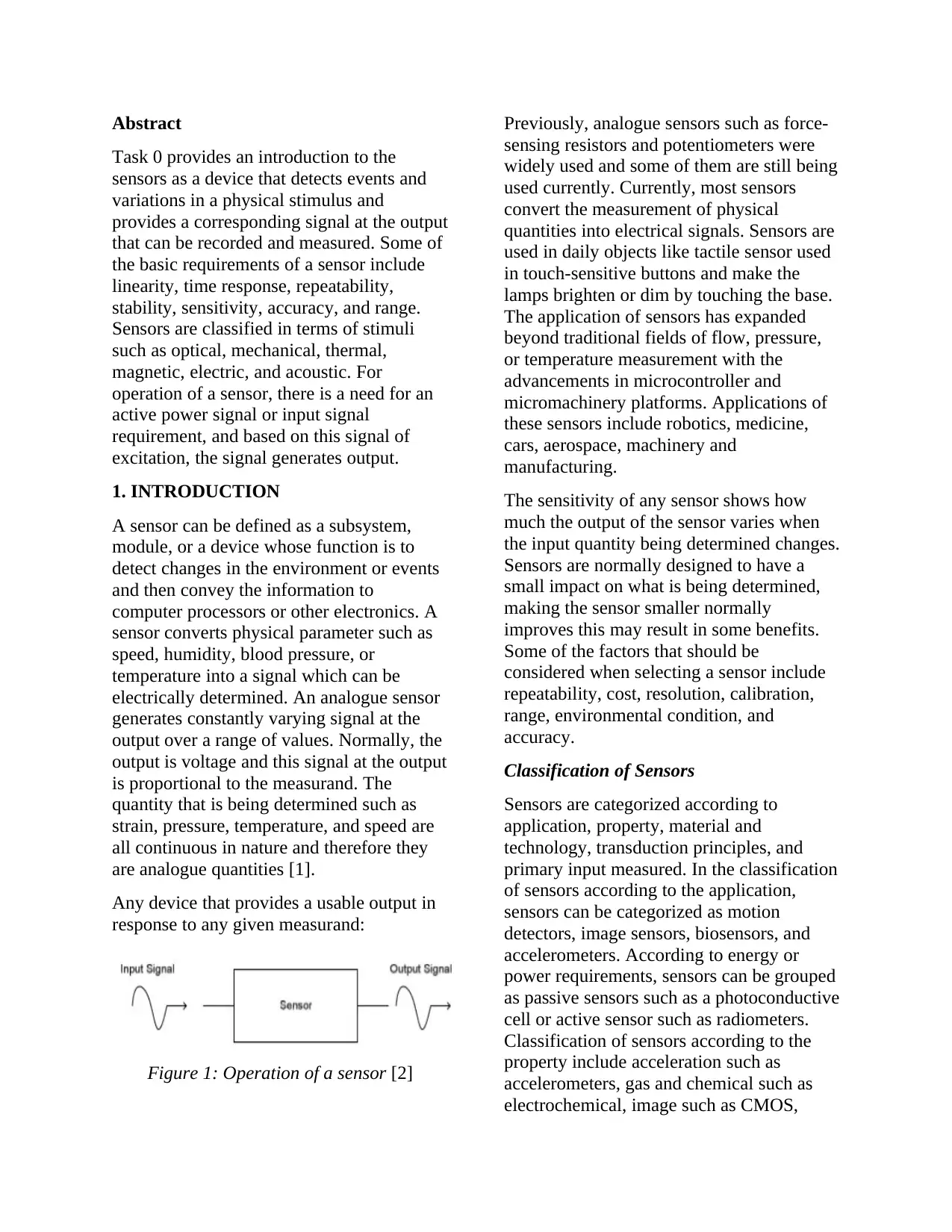
Abstract
Task 0 provides an introduction to the
sensors as a device that detects events and
variations in a physical stimulus and
provides a corresponding signal at the output
that can be recorded and measured. Some of
the basic requirements of a sensor include
linearity, time response, repeatability,
stability, sensitivity, accuracy, and range.
Sensors are classified in terms of stimuli
such as optical, mechanical, thermal,
magnetic, electric, and acoustic. For
operation of a sensor, there is a need for an
active power signal or input signal
requirement, and based on this signal of
excitation, the signal generates output.
1. INTRODUCTION
A sensor can be defined as a subsystem,
module, or a device whose function is to
detect changes in the environment or events
and then convey the information to
computer processors or other electronics. A
sensor converts physical parameter such as
speed, humidity, blood pressure, or
temperature into a signal which can be
electrically determined. An analogue sensor
generates constantly varying signal at the
output over a range of values. Normally, the
output is voltage and this signal at the output
is proportional to the measurand. The
quantity that is being determined such as
strain, pressure, temperature, and speed are
all continuous in nature and therefore they
are analogue quantities [1].
Any device that provides a usable output in
response to any given measurand:
Figure 1: Operation of a sensor [2]
Previously, analogue sensors such as force-
sensing resistors and potentiometers were
widely used and some of them are still being
used currently. Currently, most sensors
convert the measurement of physical
quantities into electrical signals. Sensors are
used in daily objects like tactile sensor used
in touch-sensitive buttons and make the
lamps brighten or dim by touching the base.
The application of sensors has expanded
beyond traditional fields of flow, pressure,
or temperature measurement with the
advancements in microcontroller and
micromachinery platforms. Applications of
these sensors include robotics, medicine,
cars, aerospace, machinery and
manufacturing.
The sensitivity of any sensor shows how
much the output of the sensor varies when
the input quantity being determined changes.
Sensors are normally designed to have a
small impact on what is being determined,
making the sensor smaller normally
improves this may result in some benefits.
Some of the factors that should be
considered when selecting a sensor include
repeatability, cost, resolution, calibration,
range, environmental condition, and
accuracy.
Classification of Sensors
Sensors are categorized according to
application, property, material and
technology, transduction principles, and
primary input measured. In the classification
of sensors according to the application,
sensors can be categorized as motion
detectors, image sensors, biosensors, and
accelerometers. According to energy or
power requirements, sensors can be grouped
as passive sensors such as a photoconductive
cell or active sensor such as radiometers.
Classification of sensors according to the
property include acceleration such as
accelerometers, gas and chemical such as
electrochemical, image such as CMOS,
Task 0 provides an introduction to the
sensors as a device that detects events and
variations in a physical stimulus and
provides a corresponding signal at the output
that can be recorded and measured. Some of
the basic requirements of a sensor include
linearity, time response, repeatability,
stability, sensitivity, accuracy, and range.
Sensors are classified in terms of stimuli
such as optical, mechanical, thermal,
magnetic, electric, and acoustic. For
operation of a sensor, there is a need for an
active power signal or input signal
requirement, and based on this signal of
excitation, the signal generates output.
1. INTRODUCTION
A sensor can be defined as a subsystem,
module, or a device whose function is to
detect changes in the environment or events
and then convey the information to
computer processors or other electronics. A
sensor converts physical parameter such as
speed, humidity, blood pressure, or
temperature into a signal which can be
electrically determined. An analogue sensor
generates constantly varying signal at the
output over a range of values. Normally, the
output is voltage and this signal at the output
is proportional to the measurand. The
quantity that is being determined such as
strain, pressure, temperature, and speed are
all continuous in nature and therefore they
are analogue quantities [1].
Any device that provides a usable output in
response to any given measurand:
Figure 1: Operation of a sensor [2]
Previously, analogue sensors such as force-
sensing resistors and potentiometers were
widely used and some of them are still being
used currently. Currently, most sensors
convert the measurement of physical
quantities into electrical signals. Sensors are
used in daily objects like tactile sensor used
in touch-sensitive buttons and make the
lamps brighten or dim by touching the base.
The application of sensors has expanded
beyond traditional fields of flow, pressure,
or temperature measurement with the
advancements in microcontroller and
micromachinery platforms. Applications of
these sensors include robotics, medicine,
cars, aerospace, machinery and
manufacturing.
The sensitivity of any sensor shows how
much the output of the sensor varies when
the input quantity being determined changes.
Sensors are normally designed to have a
small impact on what is being determined,
making the sensor smaller normally
improves this may result in some benefits.
Some of the factors that should be
considered when selecting a sensor include
repeatability, cost, resolution, calibration,
range, environmental condition, and
accuracy.
Classification of Sensors
Sensors are categorized according to
application, property, material and
technology, transduction principles, and
primary input measured. In the classification
of sensors according to the application,
sensors can be categorized as motion
detectors, image sensors, biosensors, and
accelerometers. According to energy or
power requirements, sensors can be grouped
as passive sensors such as a photoconductive
cell or active sensor such as radiometers.
Classification of sensors according to the
property include acceleration such as
accelerometers, gas and chemical such as
electrochemical, image such as CMOS,
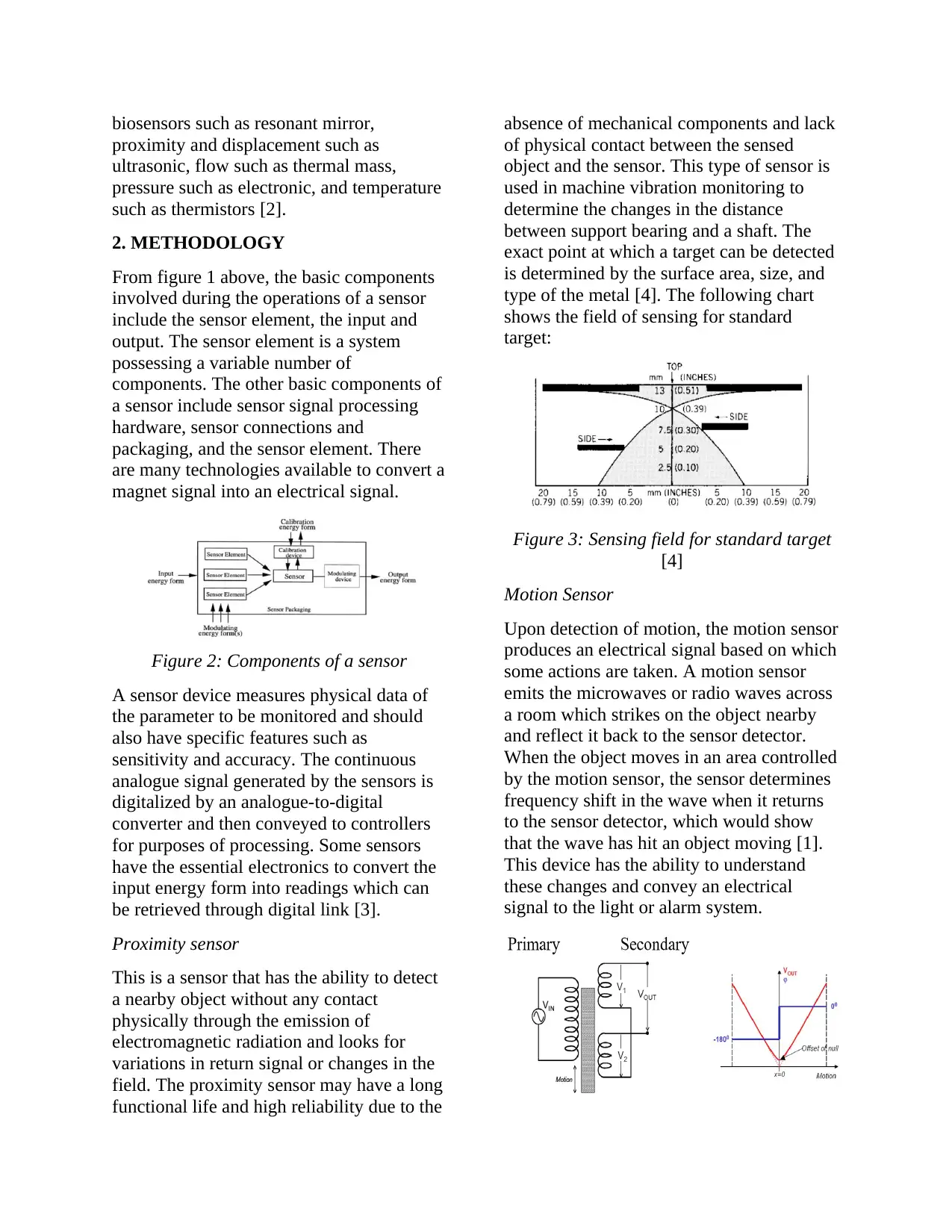
biosensors such as resonant mirror,
proximity and displacement such as
ultrasonic, flow such as thermal mass,
pressure such as electronic, and temperature
such as thermistors [2].
2. METHODOLOGY
From figure 1 above, the basic components
involved during the operations of a sensor
include the sensor element, the input and
output. The sensor element is a system
possessing a variable number of
components. The other basic components of
a sensor include sensor signal processing
hardware, sensor connections and
packaging, and the sensor element. There
are many technologies available to convert a
magnet signal into an electrical signal.
Figure 2: Components of a sensor
A sensor device measures physical data of
the parameter to be monitored and should
also have specific features such as
sensitivity and accuracy. The continuous
analogue signal generated by the sensors is
digitalized by an analogue-to-digital
converter and then conveyed to controllers
for purposes of processing. Some sensors
have the essential electronics to convert the
input energy form into readings which can
be retrieved through digital link [3].
Proximity sensor
This is a sensor that has the ability to detect
a nearby object without any contact
physically through the emission of
electromagnetic radiation and looks for
variations in return signal or changes in the
field. The proximity sensor may have a long
functional life and high reliability due to the
absence of mechanical components and lack
of physical contact between the sensed
object and the sensor. This type of sensor is
used in machine vibration monitoring to
determine the changes in the distance
between support bearing and a shaft. The
exact point at which a target can be detected
is determined by the surface area, size, and
type of the metal [4]. The following chart
shows the field of sensing for standard
target:
Figure 3: Sensing field for standard target
[4]
Motion Sensor
Upon detection of motion, the motion sensor
produces an electrical signal based on which
some actions are taken. A motion sensor
emits the microwaves or radio waves across
a room which strikes on the object nearby
and reflect it back to the sensor detector.
When the object moves in an area controlled
by the motion sensor, the sensor determines
frequency shift in the wave when it returns
to the sensor detector, which would show
that the wave has hit an object moving [1].
This device has the ability to understand
these changes and convey an electrical
signal to the light or alarm system.
proximity and displacement such as
ultrasonic, flow such as thermal mass,
pressure such as electronic, and temperature
such as thermistors [2].
2. METHODOLOGY
From figure 1 above, the basic components
involved during the operations of a sensor
include the sensor element, the input and
output. The sensor element is a system
possessing a variable number of
components. The other basic components of
a sensor include sensor signal processing
hardware, sensor connections and
packaging, and the sensor element. There
are many technologies available to convert a
magnet signal into an electrical signal.
Figure 2: Components of a sensor
A sensor device measures physical data of
the parameter to be monitored and should
also have specific features such as
sensitivity and accuracy. The continuous
analogue signal generated by the sensors is
digitalized by an analogue-to-digital
converter and then conveyed to controllers
for purposes of processing. Some sensors
have the essential electronics to convert the
input energy form into readings which can
be retrieved through digital link [3].
Proximity sensor
This is a sensor that has the ability to detect
a nearby object without any contact
physically through the emission of
electromagnetic radiation and looks for
variations in return signal or changes in the
field. The proximity sensor may have a long
functional life and high reliability due to the
absence of mechanical components and lack
of physical contact between the sensed
object and the sensor. This type of sensor is
used in machine vibration monitoring to
determine the changes in the distance
between support bearing and a shaft. The
exact point at which a target can be detected
is determined by the surface area, size, and
type of the metal [4]. The following chart
shows the field of sensing for standard
target:
Figure 3: Sensing field for standard target
[4]
Motion Sensor
Upon detection of motion, the motion sensor
produces an electrical signal based on which
some actions are taken. A motion sensor
emits the microwaves or radio waves across
a room which strikes on the object nearby
and reflect it back to the sensor detector.
When the object moves in an area controlled
by the motion sensor, the sensor determines
frequency shift in the wave when it returns
to the sensor detector, which would show
that the wave has hit an object moving [1].
This device has the ability to understand
these changes and convey an electrical
signal to the light or alarm system.
⊘ This is a preview!⊘
Do you want full access?
Subscribe today to unlock all pages.

Trusted by 1+ million students worldwide
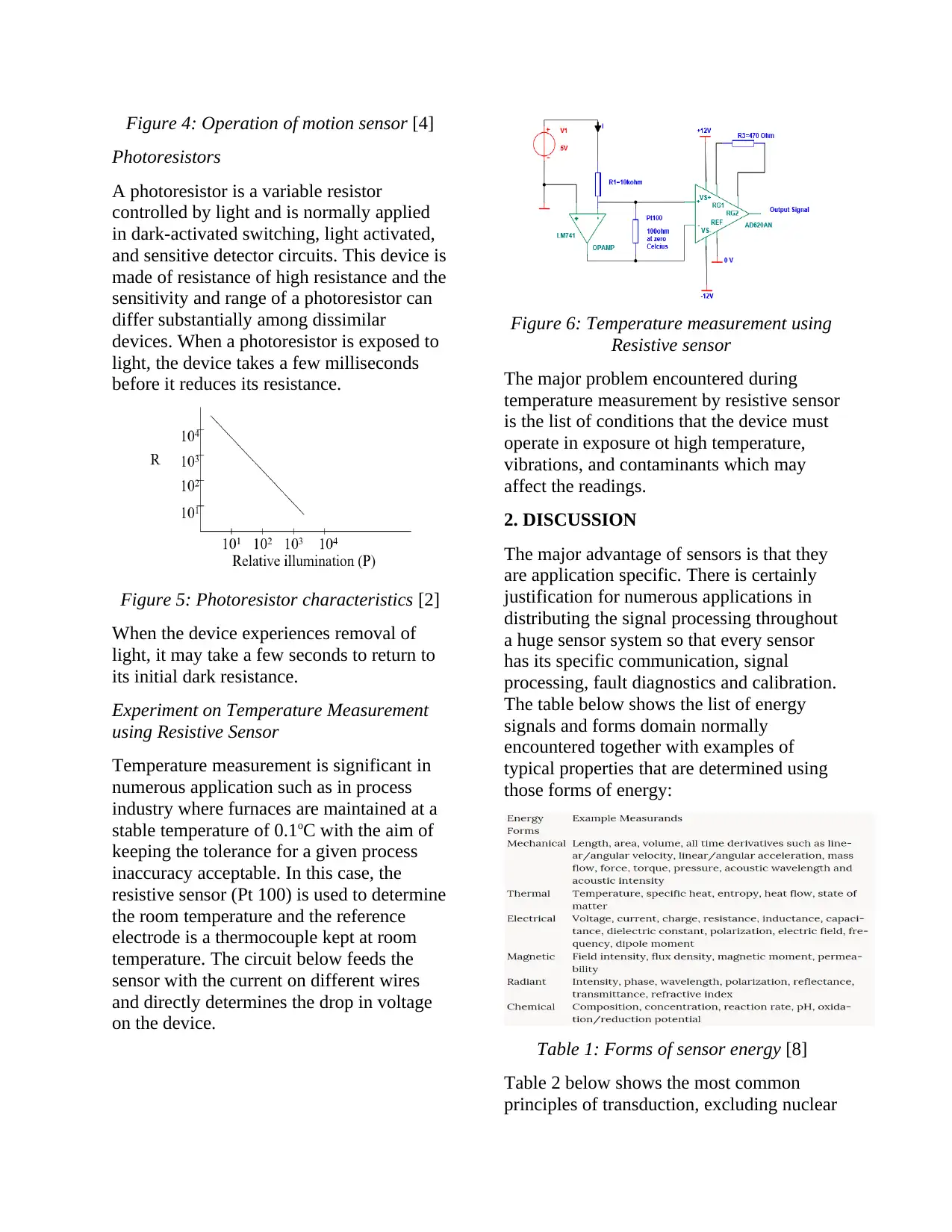
Figure 4: Operation of motion sensor [4]
Photoresistors
A photoresistor is a variable resistor
controlled by light and is normally applied
in dark-activated switching, light activated,
and sensitive detector circuits. This device is
made of resistance of high resistance and the
sensitivity and range of a photoresistor can
differ substantially among dissimilar
devices. When a photoresistor is exposed to
light, the device takes a few milliseconds
before it reduces its resistance.
Figure 5: Photoresistor characteristics [2]
When the device experiences removal of
light, it may take a few seconds to return to
its initial dark resistance.
Experiment on Temperature Measurement
using Resistive Sensor
Temperature measurement is significant in
numerous application such as in process
industry where furnaces are maintained at a
stable temperature of 0.1oC with the aim of
keeping the tolerance for a given process
inaccuracy acceptable. In this case, the
resistive sensor (Pt 100) is used to determine
the room temperature and the reference
electrode is a thermocouple kept at room
temperature. The circuit below feeds the
sensor with the current on different wires
and directly determines the drop in voltage
on the device.
Figure 6: Temperature measurement using
Resistive sensor
The major problem encountered during
temperature measurement by resistive sensor
is the list of conditions that the device must
operate in exposure ot high temperature,
vibrations, and contaminants which may
affect the readings.
2. DISCUSSION
The major advantage of sensors is that they
are application specific. There is certainly
justification for numerous applications in
distributing the signal processing throughout
a huge sensor system so that every sensor
has its specific communication, signal
processing, fault diagnostics and calibration.
The table below shows the list of energy
signals and forms domain normally
encountered together with examples of
typical properties that are determined using
those forms of energy:
Table 1: Forms of sensor energy [8]
Table 2 below shows the most common
principles of transduction, excluding nuclear
Photoresistors
A photoresistor is a variable resistor
controlled by light and is normally applied
in dark-activated switching, light activated,
and sensitive detector circuits. This device is
made of resistance of high resistance and the
sensitivity and range of a photoresistor can
differ substantially among dissimilar
devices. When a photoresistor is exposed to
light, the device takes a few milliseconds
before it reduces its resistance.
Figure 5: Photoresistor characteristics [2]
When the device experiences removal of
light, it may take a few seconds to return to
its initial dark resistance.
Experiment on Temperature Measurement
using Resistive Sensor
Temperature measurement is significant in
numerous application such as in process
industry where furnaces are maintained at a
stable temperature of 0.1oC with the aim of
keeping the tolerance for a given process
inaccuracy acceptable. In this case, the
resistive sensor (Pt 100) is used to determine
the room temperature and the reference
electrode is a thermocouple kept at room
temperature. The circuit below feeds the
sensor with the current on different wires
and directly determines the drop in voltage
on the device.
Figure 6: Temperature measurement using
Resistive sensor
The major problem encountered during
temperature measurement by resistive sensor
is the list of conditions that the device must
operate in exposure ot high temperature,
vibrations, and contaminants which may
affect the readings.
2. DISCUSSION
The major advantage of sensors is that they
are application specific. There is certainly
justification for numerous applications in
distributing the signal processing throughout
a huge sensor system so that every sensor
has its specific communication, signal
processing, fault diagnostics and calibration.
The table below shows the list of energy
signals and forms domain normally
encountered together with examples of
typical properties that are determined using
those forms of energy:
Table 1: Forms of sensor energy [8]
Table 2 below shows the most common
principles of transduction, excluding nuclear
Paraphrase This Document
Need a fresh take? Get an instant paraphrase of this document with our AI Paraphraser
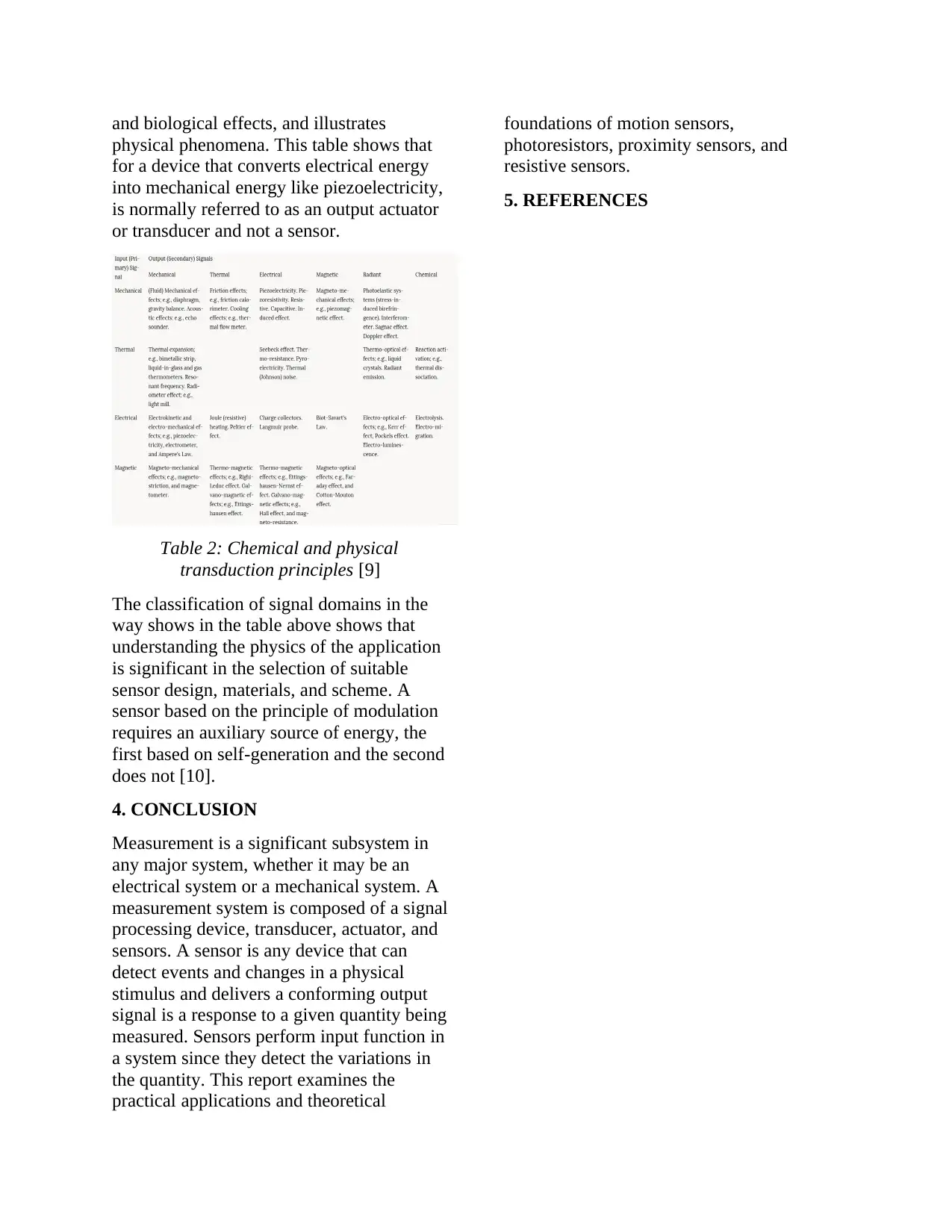
and biological effects, and illustrates
physical phenomena. This table shows that
for a device that converts electrical energy
into mechanical energy like piezoelectricity,
is normally referred to as an output actuator
or transducer and not a sensor.
Table 2: Chemical and physical
transduction principles [9]
The classification of signal domains in the
way shows in the table above shows that
understanding the physics of the application
is significant in the selection of suitable
sensor design, materials, and scheme. A
sensor based on the principle of modulation
requires an auxiliary source of energy, the
first based on self-generation and the second
does not [10].
4. CONCLUSION
Measurement is a significant subsystem in
any major system, whether it may be an
electrical system or a mechanical system. A
measurement system is composed of a signal
processing device, transducer, actuator, and
sensors. A sensor is any device that can
detect events and changes in a physical
stimulus and delivers a conforming output
signal is a response to a given quantity being
measured. Sensors perform input function in
a system since they detect the variations in
the quantity. This report examines the
practical applications and theoretical
foundations of motion sensors,
photoresistors, proximity sensors, and
resistive sensors.
5. REFERENCES
physical phenomena. This table shows that
for a device that converts electrical energy
into mechanical energy like piezoelectricity,
is normally referred to as an output actuator
or transducer and not a sensor.
Table 2: Chemical and physical
transduction principles [9]
The classification of signal domains in the
way shows in the table above shows that
understanding the physics of the application
is significant in the selection of suitable
sensor design, materials, and scheme. A
sensor based on the principle of modulation
requires an auxiliary source of energy, the
first based on self-generation and the second
does not [10].
4. CONCLUSION
Measurement is a significant subsystem in
any major system, whether it may be an
electrical system or a mechanical system. A
measurement system is composed of a signal
processing device, transducer, actuator, and
sensors. A sensor is any device that can
detect events and changes in a physical
stimulus and delivers a conforming output
signal is a response to a given quantity being
measured. Sensors perform input function in
a system since they detect the variations in
the quantity. This report examines the
practical applications and theoretical
foundations of motion sensors,
photoresistors, proximity sensors, and
resistive sensors.
5. REFERENCES
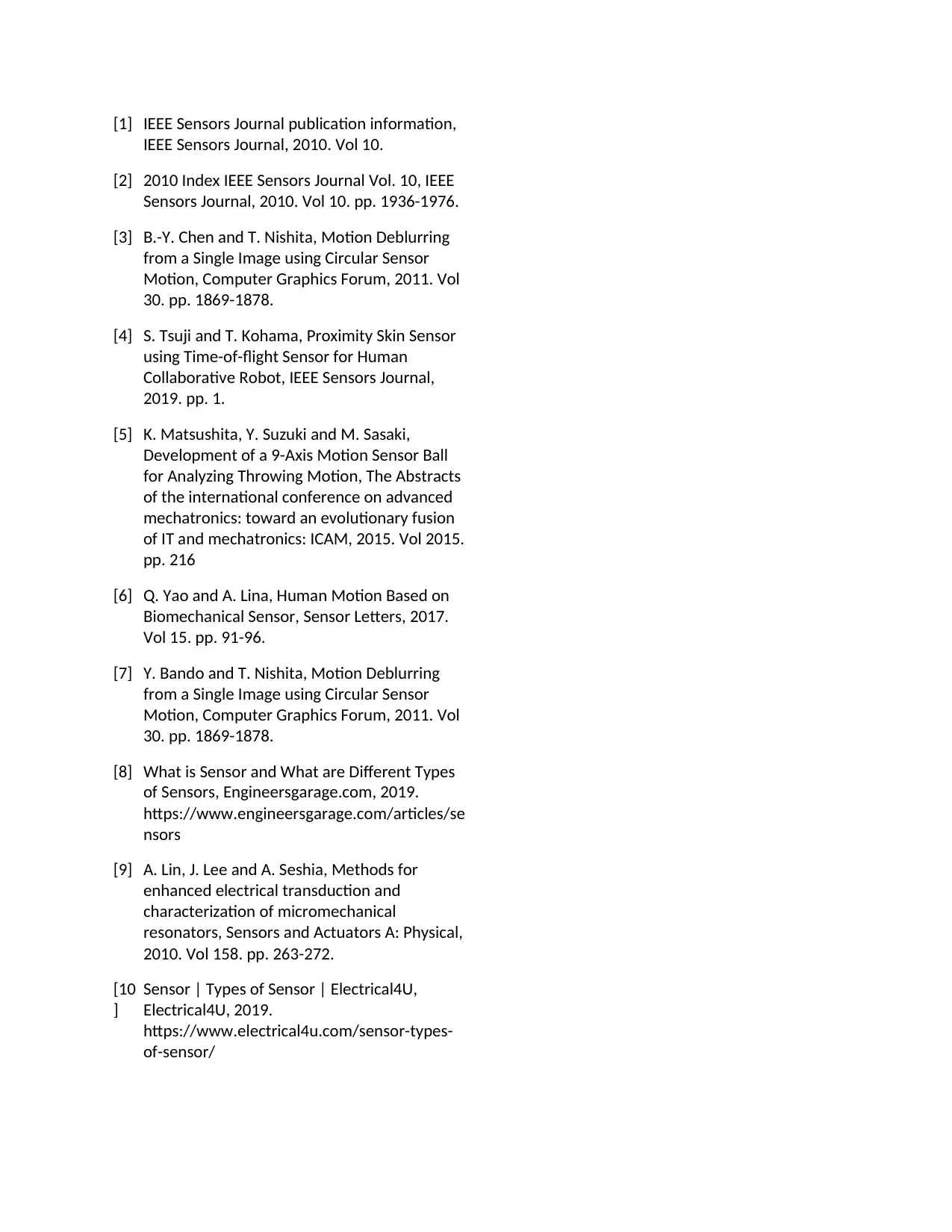
[1] IEEE Sensors Journal publication information,
IEEE Sensors Journal, 2010. Vol 10.
[2] 2010 Index IEEE Sensors Journal Vol. 10, IEEE
Sensors Journal, 2010. Vol 10. pp. 1936-1976.
[3] B.-Y. Chen and T. Nishita, Motion Deblurring
from a Single Image using Circular Sensor
Motion, Computer Graphics Forum, 2011. Vol
30. pp. 1869-1878.
[4] S. Tsuji and T. Kohama, Proximity Skin Sensor
using Time-of-flight Sensor for Human
Collaborative Robot, IEEE Sensors Journal,
2019. pp. 1.
[5] K. Matsushita, Y. Suzuki and M. Sasaki,
Development of a 9-Axis Motion Sensor Ball
for Analyzing Throwing Motion, The Abstracts
of the international conference on advanced
mechatronics: toward an evolutionary fusion
of IT and mechatronics: ICAM, 2015. Vol 2015.
pp. 216
[6] Q. Yao and A. Lina, Human Motion Based on
Biomechanical Sensor, Sensor Letters, 2017.
Vol 15. pp. 91-96.
[7] Y. Bando and T. Nishita, Motion Deblurring
from a Single Image using Circular Sensor
Motion, Computer Graphics Forum, 2011. Vol
30. pp. 1869-1878.
[8] What is Sensor and What are Different Types
of Sensors, Engineersgarage.com, 2019.
https://www.engineersgarage.com/articles/se
nsors
[9] A. Lin, J. Lee and A. Seshia, Methods for
enhanced electrical transduction and
characterization of micromechanical
resonators, Sensors and Actuators A: Physical,
2010. Vol 158. pp. 263-272.
[10
]
Sensor | Types of Sensor | Electrical4U,
Electrical4U, 2019.
https://www.electrical4u.com/sensor-types-
of-sensor/
IEEE Sensors Journal, 2010. Vol 10.
[2] 2010 Index IEEE Sensors Journal Vol. 10, IEEE
Sensors Journal, 2010. Vol 10. pp. 1936-1976.
[3] B.-Y. Chen and T. Nishita, Motion Deblurring
from a Single Image using Circular Sensor
Motion, Computer Graphics Forum, 2011. Vol
30. pp. 1869-1878.
[4] S. Tsuji and T. Kohama, Proximity Skin Sensor
using Time-of-flight Sensor for Human
Collaborative Robot, IEEE Sensors Journal,
2019. pp. 1.
[5] K. Matsushita, Y. Suzuki and M. Sasaki,
Development of a 9-Axis Motion Sensor Ball
for Analyzing Throwing Motion, The Abstracts
of the international conference on advanced
mechatronics: toward an evolutionary fusion
of IT and mechatronics: ICAM, 2015. Vol 2015.
pp. 216
[6] Q. Yao and A. Lina, Human Motion Based on
Biomechanical Sensor, Sensor Letters, 2017.
Vol 15. pp. 91-96.
[7] Y. Bando and T. Nishita, Motion Deblurring
from a Single Image using Circular Sensor
Motion, Computer Graphics Forum, 2011. Vol
30. pp. 1869-1878.
[8] What is Sensor and What are Different Types
of Sensors, Engineersgarage.com, 2019.
https://www.engineersgarage.com/articles/se
nsors
[9] A. Lin, J. Lee and A. Seshia, Methods for
enhanced electrical transduction and
characterization of micromechanical
resonators, Sensors and Actuators A: Physical,
2010. Vol 158. pp. 263-272.
[10
]
Sensor | Types of Sensor | Electrical4U,
Electrical4U, 2019.
https://www.electrical4u.com/sensor-types-
of-sensor/
⊘ This is a preview!⊘
Do you want full access?
Subscribe today to unlock all pages.

Trusted by 1+ million students worldwide

1 out of 7
Related Documents
Your All-in-One AI-Powered Toolkit for Academic Success.
+13062052269
info@desklib.com
Available 24*7 on WhatsApp / Email
![[object Object]](/_next/static/media/star-bottom.7253800d.svg)
Unlock your academic potential
Copyright © 2020–2025 A2Z Services. All Rights Reserved. Developed and managed by ZUCOL.





